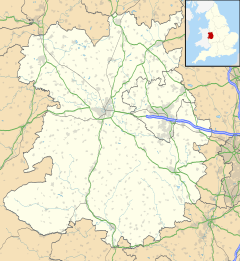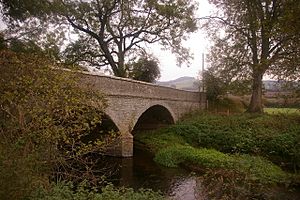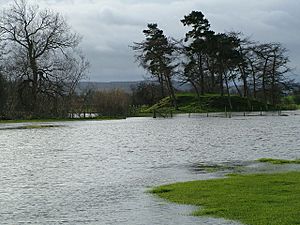Broadward facts for kids
Quick facts for kids Broadward |
|
|---|---|
 Broadward Hall |
|
| OS grid reference | SO388766 |
| • London | 159 miles (256 km) |
| Civil parish |
|
| Unitary authority |
|
| Ceremonial county | |
| Region | |
| Country | England |
| Sovereign state | United Kingdom |
| Post town | CRAVEN ARMS |
| Postcode district | SY7 0 |
| Dialling code | 01547 5 |
| Police | West Mercia |
| Fire | Shropshire |
| Ambulance | West Midlands |
| EU Parliament | West Midlands |
| UK Parliament |
|
Broadward is a small village in south Shropshire, England. Its houses are spread out, and it's located right near the border with Herefordshire. Broadward is part of the larger area called Clungunford, which is about 3.2 kilometers (2 miles) to the north.
Contents
Exploring Broadward's Location
The name Broadward is used for several buildings in the area. One important building is Broadward Hall, which is a large country house.
The River Clun flows past Broadward to the east, moving from north to south. After passing Broadward, the river leaves Shropshire and goes into Herefordshire. This part of the river is a private fishing area. The section of the River Clun just south of Broadward Bridge is so special that it's protected as a Site of Special Scientific Interest.
Broadward is generally about 130 meters (427 feet) above sea level. It sits on gently rolling land in the lower Clun Valley. The village is just above the flood plain, which is a wide, flat area. The fields between Broadward Hall and the River Clun are flood meadows, meaning they can flood sometimes. Farmers in the area grow crops and raise animals like sheep and cattle.
Broadward is located on the B4385 main road. It's also only about 0.8 kilometers (0.5 miles) from Hopton Heath railway station, which is on the Heart of Wales Line. You can catch the 740 bus service at Hopton Heath, which goes to Ludlow and Knighton three times a day.
Broadward Bridge: A Historic Crossing
The Broadward Bridge was built in 1831. This bridge carries the main road over the River Clun. It's considered a Grade II Listed building, which means it's an important historic structure.
Broadward is the southern end of the Clungunford area. Just to the north is another small village called Beckjay. You can reach Beckjay from Broadward by taking a country lane off the main road.
The closest villages with shops and services are Leintwardine (about 3.2 km or 2 miles away) and Bucknell (about 4.8 km or 3 miles away). Both have a post office, two pubs, and local convenience shops. The nearest larger towns are Knighton (in Wales), Craven Arms, and Ludlow. Ludlow is the biggest, about 14.5 km (9 miles) away. The main town of Shropshire, Shrewsbury, is about 40 km (25 miles) away by road.
Staying Connected in Broadward
Most of Broadward uses the postcode SY7 0QA. However, Broadward Barn and Broadward Bridge have their own postcode, SY7 0PZ. You can find a Royal Mail post box on the main road near the Gate Lodge. The main post town for Broadward is Craven Arms.
The phone dialling code for Broadward is 01547. Most of the village uses 530, which is the Bucknell exchange. Broadward Barn and Broadward Bridge use 540, which is the Leintwardine exchange.
Broadward's Past: A Look Back in Time
Broadward Hall is a Grade II Listed building. It looks like a castellated (castle-like) Gothic house. Most of it was rebuilt in the 1800s, but it started as an 18th-century house. Broadward itself is much older, dating back to medieval times. It was once a small settlement with its own area within the Clungunford parish. Broadward Hall is a private home and is not open to visitors.
The hall used to be part of the Hopton Castle Estate. For 200 years, it was home to the Bayley family. In 1943, a group called the Bilston Corporation bought it, planning to turn it into a children's home. But this didn't happen, and in 1947, Thomas Watkins bought it. Today, the hall is still a private home, and there's a small sheep farm on the estate.
What's in a Name?
The name "Broadward" comes from "broad ford". A ford is a shallow place where you can cross a river. We don't know exactly where this old ford was, and there isn't one there today. The crossing is now the Broadward Bridge. Interestingly, the name changed from "ford" to "ward," which is the opposite of what happened with the name of Clungunford!
Ancient Discoveries
East of Broadward Hall, next to a public footpath, you can find the remains of an old motte. A motte is a type of small hill that was part of a castle. This one dates back to medieval times, after the Normans took over England. It was built to control the crossing of the River Clun (where the old ford used to be). It was only big enough to hold a watch tower. This motte is located roughly halfway between similar mottes at Clungunford and Leintwardine, which are also by the River Clun. This motte is now a protected scheduled monument.
Many Bronze Age items have been found near Broadward Hall. These include spearheads and pieces of swords. The first discoveries were made in 1867 during digging for drainage. Many of these findings are now in the British Museum and are part of what's called the Broadward complex. The items were found over a meter (about 3 feet) below the ground. Experts believe they were offerings to water gods in what was once a very marshy area. Over time, the ground level has risen naturally due to floods depositing soil, and the area has also been drained for farming.




